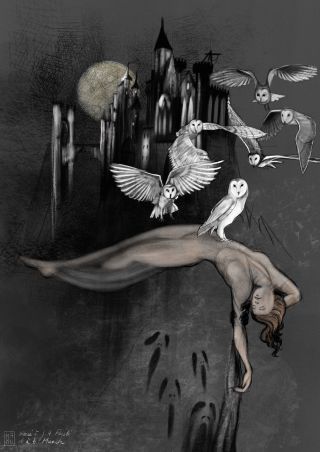Animal Behavior
Ghosts Are White for a Reason and So Are Barn Owls
It pays off to be white under the moonlight.
Posted April 25, 2023 Reviewed by Ekua Hagan
Key points
- Barn owls range in color from white to dark reddish-brown.
- Reddish barn owls hunt more successfully in darkness under the new moon, while white barn owls hunt more successfully in full moon.
- White barn owls might appear like ghosts to their prey.

Some nights are predestined to be mysterious and frightening. On such nights, we are alone in a park, forest, vaulted cellar, warehouse, or big old house, perhaps a castle. It’s so dark that we can hardly see our hands. The smallest sound sends shivers up and down the spine. We might hear cracks in the woods, see glimmering light between the leaves or a shelf, or feel the presence of somebody unknown. Depending on where we are, the scene may also be covered in moonlight so that we easily see contours, moving shades, and shimmering objects. It is now or never to meet a scary white ghost.
Well, this ghost scenario might mirror a prey’s experience when encountering a white barn owl (Tyto alba) flying above its head searching for food. At night, the barn owl father hunts for food to feed the family, whereas the mother protects its offspring and gives it warmth. Barn owls’ favorite dishes consist of voles, but mice and other small rodents are consumed as well. From the age of about one month, chicks are so hungry that they have no time to dissect the prey; they binge it in one go. Thus, the father is under high pressure to hunt successfully. In a good year, he might have to feed up to 10 chicks, each eating three to four prey per night (Roulin, 2020).
Hunting is not an easy task, though. Barn owl fathers can expect to capture prey every one in four attempts. Thus, it really matters under which conditions he has a higher hunting success. Studies have shown that white barn owls are more successful hunters than reddish-brown barn owls when there is a full moon (San José et al. 2019). This difference is unexpected, because white feathers reflect the moonlight the best, making white barn owls more visible than their reddish-brown relatives. As white owls are better seen, the prey should detect the dangerous predator more rapidly and flee. Yet, that’s not what the researchers have found.
Studies on hunting success in white and reddish barn owls

In a series of studies, Alexandre Roulin and collaborators demonstrated that white barn owls are better hunters during full moon (San José et al., 2019). In their first study, they fixed an infrared-sensitive video camera next to the entrance of nest boxes. They counted how many times parents returned with prey each night. They also had data on the moon cycle to compare hunting success under a new moon and a full moon. As expected, they observed that reddish parents brought more prey during the new moon. In general, nocturnal predators are more successful during the new moon, because darkness hides them from their prey. In contrast, during a full moon, rodents seem more cautious and stay longer in their burrows. Perhaps, they have some understanding that predators can see them better when the full moon is shining on them. Surprisingly, white barn owls were more successful hunters under a full moon than the new moon.
In the next study, the researchers obtained equivalent results. This time, they analyzed a dataset on naturally living owls which was spanning over 30 years. Concretely, they looked at the body mass of chicks per couple. If raised by white fathers, the chicks were heavier, and by inference, better fed, when there was a full moon. If raised by reddish fathers, the chicks were heavier when there was a new moon.
In yet another study, the researchers fitted a non-invasive GPS system on the back of some barn owls so to assess how the bird was hunting. They again found that reddish but not white owls had a lower hunting success during a full moon. Thanks to the GPS data, they observed that white owls preferred to hunt facing the moon during the attack. Moonlight was directly shining on their white plumage making them even more visible to their prey. It seemed as if they didn’t try to hide from prey but wanted to be seen. Why did they do that?
To find an answer, the researchers went to the laboratory to investigate the reaction of voles in the presence of a barn owl. They presented a white or reddish stuffed barn owl under either a new moon or full moonlight conditions. In their experiment, the stuffed barn owl moved along a zip-line above a cage hosting voles. When the stuffed barn owl moved towards them, voles stopped moving (in other words, “froze”) for about nine seconds. Yet, freezing duration varied by barn owl plumage color and moon condition. Voles froze for about nine seconds longer when approached by the white owl under the full moon compared to the new moon condition. Under the full moon condition, voles also froze for about five seconds longer when the white barn owl rather than the reddish barn owl was approaching. Thus, the white barn owl would have had more time to capture the prey under full moon conditions than the reddish barn owl. To test whether said color effects were really due to the reflective properties of white feathers, the researchers covered the white plumage with a transparent oil. The white feathers were still white but did not reflect light. Under these circumstances, vole freezing behavior was comparable for the approaching white as well as reddish barn owls.
Back to ghosts
The research team demonstrated that it pays off to be a white barn owl because its prey gets startled and freezes before it can run away. White barn owls may have the same scary effect on their prey as ghosts have on most humans. Yet, if being white is so advantageous, why is the white barn owl the only nocturnal predator having evolved this ghostly appearance*? The answer lies in probability and evolution. If more predators were white, it would be much more likely that rodents had evolved a different kind of behavior, namely to escape and not freeze when facing white predators. Thus, if you are a ghost, you'd better be rare to scare.
*There is also the snowy owl (Bubo scandiacus), but this white owl profits from its white color to camouflage in the snow and not to hunt more successfully.
References
Barn Owl Research (website). https://www.chouette-effraie.ch/en
Roulin A. 2020. Barn Owls — Evolution and Ecology. Cambridge University Press. 297 pages. https://www.cambridge.org/core/books/barn-owls/A887801025A057F4B8A7FC27BB47EF46
Roulin A. 2021. L’Effraie des clochers — Description, Comportement, Vie sociale. Délachaux & Niestlé. 328 pages.
Roulin A. 2022. Die Schleiereule — Evolution und ökologie. Springer Verlag.
San José L, Séchaud R, Schalcher K, Judes C, Questiaux A, Oliveira-Xavier A, Gémard C, Almasi B, Béziers P, Kelber A, Amar A, Roulin A. 2019. Differential fitness of moonlight on plumage colour morphs in barn owls. Nature Ecology and Evolution 3, 1331-1340. https://doi.org/10.1038/s41559-019-0967-2


